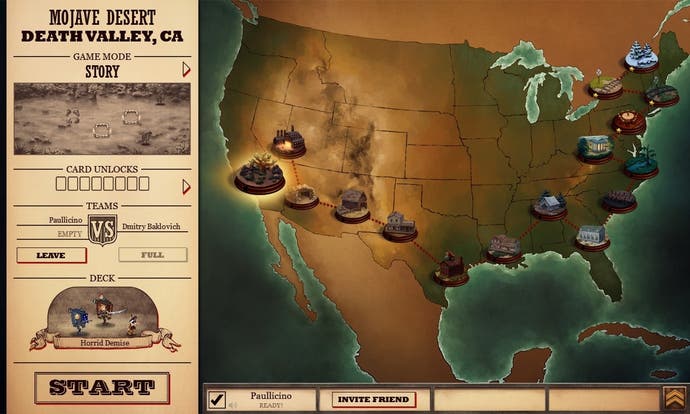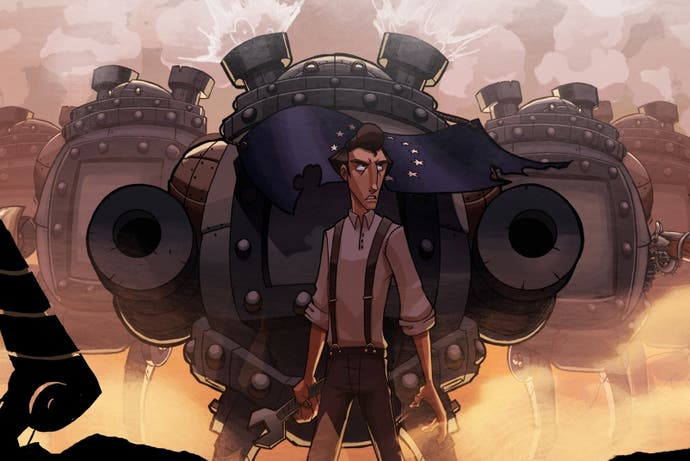Ironclad Tactics review
Raw deal.
"No plan survives first contact with the enemy," or so said Helmuth von Moltke, one of the great military minds of the 19th century. Von Moltke was on the wrong side of the Atlantic to witness the American Civil War, but he would've no doubt insisted that his aphorism applied to conflicts everywhere, even those that featured alternate histories with airships and automata, decks and dealing. In any battle, improvisation is key.
Such are the technologies and trappings of Ironclad Tactics, which puts a steampunk spin on 1860s America. As it stomps its way around the States, it places an ever-growing array of weird and wonderful war machines at your command, all of them represented in a colourful, cartoon style. From this roster, it's your job to assemble armies that will stride to victory.
Ironclad Tactics are tabletop tactics, as all of this functions via the mechanics of a collectible card game. Each unit is a card, each card has a deployment cost and each army is a deck of these cards that has been custom-built by its owner. As well as the great puffing buckets of bolts that are the ironclads, some cards also represent attachments such as armour and weapons, or smaller, nimbler support units that scuttle about the battlefield.

Those battlefields are divided into lanes that run horizontally across the screen, and it's in these that you'll deploy your units, facing off against whatever forces your opponent has snuggled up their sleeve. Most scenarios are about shunting your units to the other end of the battlefield to score points while keeping your own defences as tight as a gasket.
But it's not played in turns; instead, the game ticks away in real time, resolving attacks, actions and movement like clockwork. Ironclads constantly inch forward, snipers take their shots and both sides gain more of the action points they need to spend to deploy more forces. It's up to you whether you risk waiting for the points to accrue before sending in the cavalry, or if you prefer deploying more, cheaper units to counter whatever's coming at you.
This immediately gives the game a constant, itchy sense of impatience, and Ironclad Tactics never stops asking you to make difficult decisions about what to do next. Five of your cards are laid out in front of you and, by the time the next turn ticks around, the last will have been nudged out of play and replaced by something new. It's up to you to choose whether to try and block a lane the enemy is surging down, to make your own dash for the other side, or to weld a weapon onto a unit that could swing the balance of the battle.

Choose quickly. Sure, you've built your deck and you'll have a vague idea of what sort of cards you might be looking at next, but von Moltke was right. Improvisation really is key. This is a game of thinking on the fly.
It's also a battle of attrition when ironclads start to butt heads en masse. As the lanes start to become crowded, you're quietly calculating how much damage each attack is going to do this turn, or next turn, or which units are behind which other units and how their attacks will stack. Although the battles aren't always long, they can feel laborious, and it's often possible to see victory or defeat many moves off.
Once the advantage shifts, it's difficult to redress it, and so a gradually-rising momentum often wins the day. It doesn't help that a strong starting hand can have a considerable impact on a battle, allowing you to deploy particular units with particular weapons, while the best solution to a poor draw is often to restart. I found this all too true during some of the earlier parts of the single-player campaign, where unforgiving opening hands could be a big setback in scenarios that demanded quite specific solutions.

That campaign gets off to a slow and sometimes punishing start, with fate too much of an arbiter. Exactly the same deck that saw you ruined, that had you carefully examining your card choices, could then go on to lead you to victory thanks to some slightly different deals. But give Ironclad Tactics a couple of hours and it will improve in both the challenges it offers and the variety of things it gives you to play with. Making almost any sort of progress in the game means you receive more cards, and you want, you need more cards to have a much better time.
Move through the campaign and you'll receive more cards - often the exact cards you'll need to deploy to beat the next mission. Beat opponents in multiplayer and you'll receive more cards. Complete campaign-related puzzles, which introduce new cards, and you'll then receive those cards as rewards. In time you get to build a deck that gives you options and that suits your style, but your first experiences of the game are repeated raps to the knuckles as it insists you deploy your new acquisitions, or as your first forays into multiplayer see you facing units you don't understand, displaying abilities never before seen on the field of battle.
Unfortunately, there's no way to inspect your opponent's decks, nor even to learn anything much about them, and you soon see that Ironclad Tactics' multiplayer is criminally underdeveloped. It's a terrible shame, because it can be a lot of fun, and it's exactly where a deck-building game should shine. There's nothing more to matchmaking than a one-on-one versus mode that spends a very long time silently scraping at every corner of the internet before it finds anyone to match you with.

I'm sure this is because there just aren't enough players around right now, but a better interface certainly wouldn't hurt, and it could let those players know exactly how many of their peers are out there and what they're available for. While there are options to play through parts of the campaign with others, they'll have to already be Steam friends, as there are no tools to help you pair up with strangers.
Ironclad Tactics feels like a game that was released too soon. Its campaign could have done with a little more polish, its multiplayer with more tools and its mechanics with a gentle rebalancing. Nevertheless, it certainly does do the deck-building thing very well, with scores of often remarkably different cards to choose from, strict limitations that cause some serious pondering (20 cards only, please, chosen from just two factions) and a simple, smart interface that makes tweaking and fine-tuning your deck a doddle.
If a few joints can be tightened, a few rough edges filed down, Ironclad Tactics could hum along nicely. For now, however, I wouldn't recommend you climb aboard this one. It's a rickety ride.

